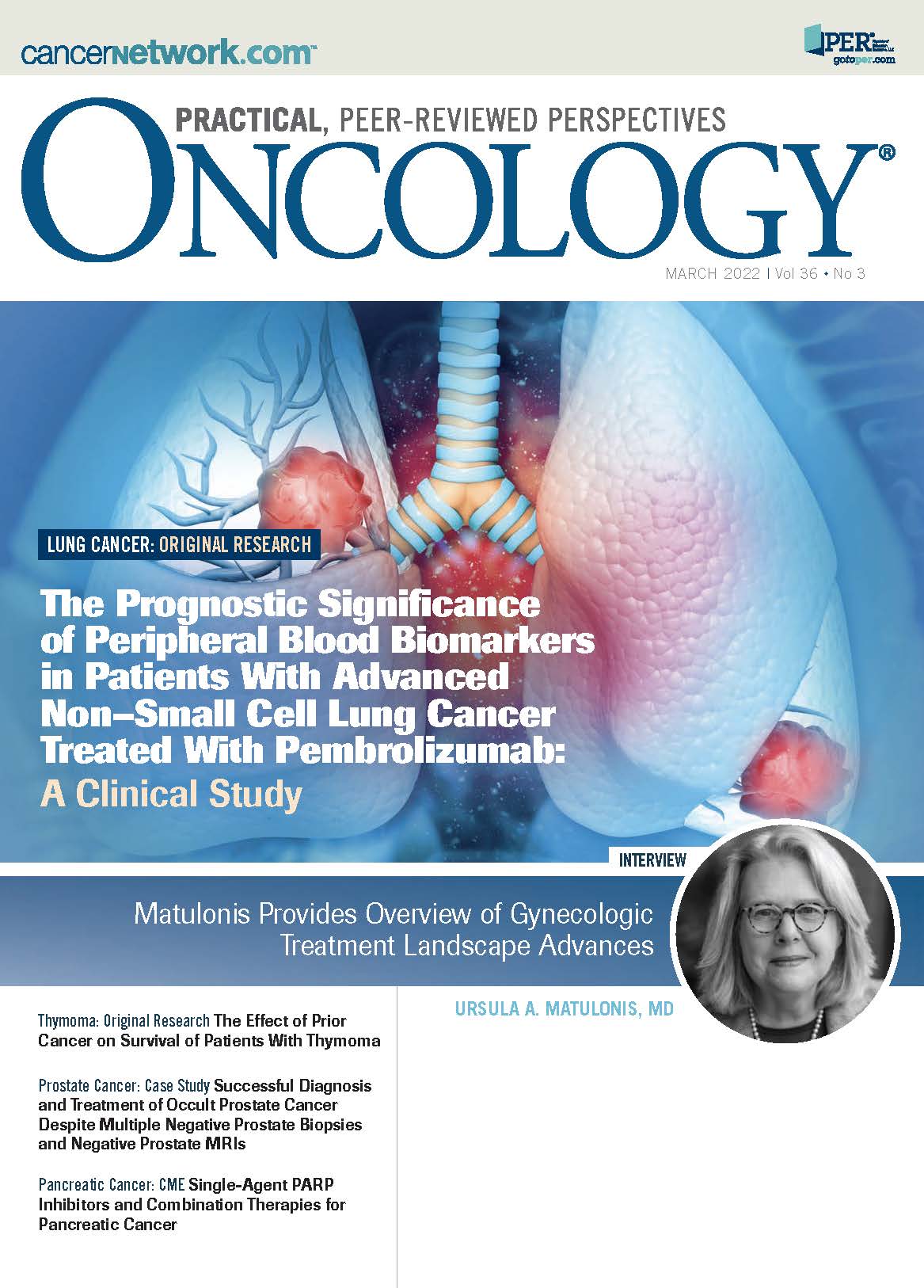Matulonis Provides Overview of Gynecologic Treatment Landscape Advances
“Team science is important for being open-minded [and] thinking outside of the box.”
Ursula A. Matulonis, MD, chief of the Division of Gynecologic Oncology and Brock-Wilson Family Chair at Dana- Farber Cancer Institute as well as professor of medicine at Harvard Medical School in Boston, Massachusetts, is co-chair of the upcoming 13th Annual International Symposium on
Ovarian Cancer and Other Gynecologic MalignanciesTM hosted by Physicians’ Education Resource®, LLC (PER®).

The landscape of gynecologic oncology continues to evolve quickly, with the FDA approving multiple treatments for ovarian, endometrial, and uterine cancer in the last few years. Moreover, investigators continue to explore new treatment combinations to provide patients with more options and help improve survival.
In an interview with ONCOLOGY®, Ursula A. Matulonis, MD, discussed clinical trials that have significantly impacted the standard of care (SOC), as well as ongoing studies that have practice-changing potential. She also spoke about several trials that will be presented at the upcoming Society of Gynecologic Oncology (SGO) conference.
Matulonis detailed what made her change her own practice and described trends observed throughout the community. She even touched upon advice she gives to new faculty who are beginning their work in clinical trials.
Q:Can you give a brief overview of the recent gynecologic treatment landscape?
A: The top billing goes to cervical cancer because of what has happened over the past year, [with immuno-oncology (IO) agents becoming available for] patients with newly diagnosed advanced or recurrent cervical cancer. Testing and introduction of IO agents into SOC treatment for cervical cancer was recently published [KEYNOTE-826; NCT03635567] in the New England Journal of Medicine [with the addition of] pembrolizumab [Keytruda] to carboplatin and paclitaxel plus or minus bevacizumab [Avastin].1
In uterine cancer, the SOC now is single-agent IO drugs, specifically pembrolizumab and dostarlimab [Jemperli], which got an FDA accelerated approval in 2021 for microsatellite instability or mismatch repair–deficient endometrial cancer.2 Pembrolizumab is approved as a single agent for TMB [tumor mutational burden]–high (ie, greater than 10 mutations per megabase) [disease] and for microsatellite-deficient disease as well.3,4 That is a viable option post chemotherapy for those patients with recurrent endometrial cancer.
KEYNOTE-775 [NCT03517449], which was published in the New England Journal of Medicine, [also investigated and showed benefit of] pembrolizumab and lenvatinib [Lenvima] vs chemotherapy for microsatellite-proficient recurrent uterine cancer that has progressed through at least 1 round of platinum [chemotherapy].5
Ovarian cancers are a different story, and the only approval of an IO agent in ovarian cancer is pembrolizumab for microsatellite instability or high TMB [tumor-agnostic indications], but IO does not have any formal indications right now. Additionally, new therapies are being tested, specifically
antibody-drug conjugates [ADCs].
Finally, there is a trend of targeting specific drugs to specific tumors with ADCs. All IOs, to a certain extent, have targets with either microsatellite instability or stability as a biomarker. ADCs like tisotumab vedotin don’t have a marker, but the FDA approval doesn’t indicate that [there must be] tissue factor present.6 Other ADCs, namely mirvetuximab, that require a biomarker are being tested.
Q: What biomarkers for, if any, should be explored in clinical research?
A: Basket trials are good if there is a true target. If a target is being considered—for example, [targeting] HER2 with DS-8201a [trastuzumab deruxtecan; T-DXd], which is an anti-HER2 ADC— investigators can get a sense of what the level of expression of HER2 has to be [to see efficacy].
Some tumors in gynecologic cancers have RAS mutations, such as low-grade serous mucinous cancers of the ovary and endometrioid cancers of the uterus, but they are not targetable. [Gynecologic] cancers [can] have [RAS] G12D and G12V mutations, [and] they’re not targetable by known inhibitors quite yet. If [we] had a drug that could potentially target those mutations, then [we] could line up the different gynecologic cancers that have those RAS mutations. Basket trials are a neat way of not having to [conduct] 10 different phase 2 studies, but package them all into one trial.
Q: What role do you think PARP inhibitors play? Are any practice-changing trends on the horizon?
A: Three PARP inhibitors are approved in the United States for newly diagnosed advanced-stage cancer. One is based on the SOLO-1 trial [NCT01844986], with 2 years of maintenance olaparib [Lynparza] for patients who have BRCA1/2-mutated cancer after response to chemotherapy.7 SOLO-1 has certainly been a practice-changing trial since that initial presentation a few years ago at the [European Society for Medical Oncology] Congress. My practice immediately changed because the progression-free survival improvement was dramatically better in SOLO-1 vs placebo.
The second trial is PRIMA [NCT02655016], using niraparib [Zejula] maintenance for about 3 years, which expands to high-grade serous [cancer] with no BRCA mutation regardless of homologous recombination deficiency [HRD] status.8 Then, the PAOLA-1 trial [NCT02477644], adds olaparib to bevacizumab [Avastin] as maintenance for patients who receive some bevacizumab for at least 3 cycles during their upfront carboplatin or paclitaxel chemotherapy.9 Olaparib received approval for cancers with HRD. If the tumor is deemed [homologous recombination proficient] per an FDA-approved assay, then olaparib [maintenance is not indicated].
Rucaparib [Rubraca] then came along for either BRCA-mutated or HRD platinum-sensitive [disease]; you can use it in that setting as well and then as maintenance treatment.10
Q: Should clinicians be aware of other agents?
A: The drug adavosertib in recurrent uterine serous cancers [is a Wee1 inhibitor]. The concept is that the whole genome is under stress from different mechanisms, with loss of p53 allowing the agent to work. There’s cyclin E amplification, MEK amplification, and HER2 overexpression. These data were published in the Journal of Clinical Oncology, which showed a 29% response rate with single-agent adavosertib in recurrent uterine serous cancers. This has led to a larger trial called ADAGIO [NCT04590248]; it’s closed for the moment, but it will reopen.11
Additionally, the [combination of] CDK4/6 inhibitor abemaciclib [Verzenio] plus letrozole has data that are being presented at the SGO Annual Meeting on Women’s Cancer in [mid-March]. This is a phase 2 trial [NCT03675893] in recurrent estrogen receptor–positive endometrial cancers.
Another trial of DS-8201a plus olaparib, a [National Cancer Institute]–sponsored trial [NCT04585958] for HER2-positive gynecologic cancers, is
mostly [looking at] endometrial serous cancers.
[Yet another trial] is looking at mirvetuximab, which is an ADC against the folate receptor α, plus pembrolizumab in recurrent uterine serous cancers. About 30% of uterine serous cancers are folate receptor α–positive, and we prescreened those patients [beforehand].
Q: What advice do you have for new clinicians?
A: They must understand the patient they’re treating to gain ideas about what should be done. Currently, per year in the United States, there are fewer than 13,000 cases of cervical cancer, about 20,000 ovarian, and 66,000 uterine. [These clinicians must] become experts. [They begin by] writing it up [a trial] and presenting it at a meeting. [When working on this], everybody needs to be incorporated, from surgeons to medical oncologists, radiation oncologists, pathologists, and basic scientists, depending upon the project that you want to start. Team science is important for being open-minded and thinking outside of the box.
References
1. Colombo N, Dubot C, Lorusso D, et al; KEYNOTE-826 Investigators. Pembrolizumab for persistent, recurrent, or metastatic cervical cancer. N Engl J Med. 2021;385(20):1856-1867. doi:10.1056/NEJMoa2112435
2. FDA grants accelerated approval to dostarlimab-gxly for dMMR advanced solid tumors. FDA. August 17, 2021. Updated February 1, 2022. Accessed February 10, 2022. https://bit.ly/3HKBNY7
3. FDA approves pembrolizumab for adults and children with TMB-H solid tumors. FDA. June 17, 2021. Accessed February 11, 2022. https://bit.ly/3BthkFb
4. FDA grants accelerated approval to pembrolizumab for first tissue/site agnostic indication. FDA. May 23, 2017. Updated May 30, 2017. Accessed February 11, 2022. https://bit.ly/3sSnNWj
5. Makker V, Colombo N, Casado Herráez A, et al; Study 309–KEYNOTE-775 Investigators. Lenvatinib plus pembrolizumab for advanced endometrial cancer. N Engl J Med. 2022;386(5):437-448. doi:10.1056/NEJMoa2108330
6. FDA grants accelerated approval to tisotumab vedotin-tftv for recurrent or metastatic cervical cancer. FDA. September 21, 2021. Accessed February 10, 2022. https://bit.ly/3Bhei6O
7. Moore K, Colombo N, Scambia G, et al. Maintenance olaparib in patients with newly diagnosed advanced ovarian cancer. N Engl J Med. 2018;379(26):2495-2505. doi:10.1056/NEJMoa1810858
8. González-Martín A, Pothuri B, Vergote I, et al; PRIMA/ENGOT-OV26/GOG-3012 Investigators. Niraparib in patients with newly diagnosed advanced ovarian cancer. N Engl J Med. 2019;381(25):2391-2402. doi:10.1056/NEJMoa1910962
9. Ray-Coquard I, Pautier P, Pignata S, et al; PAOLA-1 Investigators. Olaparib plus bevacizumab as first-line maintenance in ovarian cancer. N Engl J Med. 2019;381(25):2416-2428. doi:10.1056/NEJMoa1911361
10. FDA approves rucaparib for maintenance treatment of recurrent ovarian, fallopian tube, or primary peritoneal cancer. FDA. April 6, 2018. Accessed February 11, 2022. https://bit.ly/3Js2wtb
11. Liu JF, Xiong N, Campos SM, et al. Phase II study of the WEE1 inhibitor adavosertib in recurrent uterine serous carcinoma. J Clin Oncol. 2021;39(14):1531-1539. doi:10.1200/JCO.20.03167
